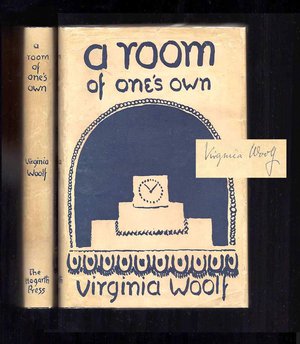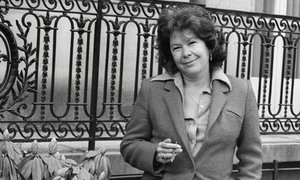Shakespeare’s Sister at the King’s 'What You Will' Festival
Post by Emma Whipday, Teaching Fellow in Shakespeare and Early Modern English Literature

A first edition of Woolf's 1929 feminist essay
'Let me imagine, since the facts are so hard to come by, what would have happened had Shakespeare had a wonderfully gifted sister, called Judith, let us say.'
Virginia Woolf, A Room of One’s Own
When Woolf invented a brief history of Judith Shakespeare in A Room of One’s Own, she suggested that it would have been impossible for any woman to write the plays of Shakespeare in the age of Shakespeare. Woolf’s Judith ran away to London, aged sixteen, to write plays, but the men of the theatre laughed in her face. She had an affair with actor-manager Nick Greene, became pregnant by him, and killed herself.
In my play Shakespeare’s Sister, recently published by Samuel French and performed in a staged reading at the King’s ‘What You Will Festival’ in February 2016, I follow Woolf in reimagining the life of a canonical writer from the perspective of those who were forbidden the roles of actor and writer: the women who lived on the edge of the world of the theatre, but couldn’t inhabit it. Along with the fictional playwright Judith Shakespeare, my play is populated with characters an Elizabethan actor would have recognised: Edward Alleyn, Richard Burbage, Philip Henslowe, his step-daughter Joan, Lucy Morgan, Dorothy Clayton, Augustine Phillips, and Thomas Egerton all existed, though I’ve taken some liberties with dates and circumstances. In peopling Elizabethan London with the names and personalities that walked its streets, I’ve tried to bring to life the vivid, dirty, and astonishing world of early modern theatre-makers.
I also aimed to engage with the rich history of female writing and acting in early modern England – a history that is rarely included in accounts of early modern performance. As Pamela Allen Brown explored in her essay collection Women Players in England, 1500-1660: Beyond the All-Male Stage (2008), the prevailing narrative of the period as exclusively peopled by male actors and theatre-makers fails to take account of female non-professional performance. There were female performers in early modern England – and there were also female playwrights.
In around 1555, Lady Jane Lumley, then in her late teens, wrote The Tragedie of Euripedes called Iphigeneia, translated out of Greake into Englisshe – the earliest English translation of Euripides’ play, and (as far as we know) the first play written by a woman in English. It was never published, but the manuscript of the play circulated among her friends, and it may have been performed in private. Lumley was not alone - Mary Sidney, Countess of Pembroke, wrote a translation of French playwright Robert Garnier’s Marc-Antoine, which she called Antonius, based on the final days of Mark Antony. It was published in 1592, and Sidney commissioned a sequel from writer and tutor Samuel Daniel, The Tragedie of Cleopatra, in an example of woman who inhabited the dual role of playwright and of patron.
In 1613, the first original play by a woman appeared in print – The Tragedy of Mariam, by Elizabeth Carey, Lady Falkland. Although based on the Biblical tale of Mariam, her husband Herod, and his sister Salome, the play is not a translation, but an entirely new play – a significant development in the history of women’s writing. In imagining what Shakespeare’s sister might have written, I followed Carey’s example in having her create a play based on a Biblical tale. Unlike the female playwrights whose work survives today, Judith Shakespeare wouldn’t have had a classical education, but she might have drawn her inspiration from Biblical tales, as Carey did.

Marilyn French
I’m not the first writer to reimagine the fate of Woolf’s Judith Shakespeare. In Marilyn French’s ground-breaking feminist novel The Women’s Room (1977), French imagines Judith’s life through the prism of the novel’s interest in sexual violence and the unequal power structure in contemporary marriage. French’s Judith tries to follow her brother to London, but ‘never got there’: she is ‘raped the first night out’, and must find a credulous man in the next village to agree to marry her, in order ‘to keep herself and her child safe’:
'But Shakespeare’s sister has learned the lesson all women learn: men are the ultimate enemy. At the same time she knows that she cannot get along in the world without one. So she uses her genius, the genius she might have used to make plays and poems with, in speaking, not writing. She handles the man with language: she carps, cajoles, teases, seduces, calculates, and controls this creature to whom God saw fit to give power over her, this hulking idiot who she despises because he is dense and fears because he can do her harm (p.46).'
French uses the example of Shakespeare’s sister to emblematize the concerns of second wave feminism. This is just one example of the myriad of the cultural appropriations of Woolf’s tantalising figure – from the highly successful 90s pop duo and a song by The Smiths to playwriting fellowships, short film initiatives, and a 2012 exhibition on women writers at the Folger Shakespeare Library (‘Shakespeare’s Sisters: Voices of English and European Women Writers, 1500-1700’).
The figure of Shakespeare’s sister has become a form of shorthand for the cultural invisibility of women’s creative work, and the challenges faced by female writers. Each appropriation tells a very different tale about Judith Shakespeare, in ways that resonate with the time in which they’re written. My own play explores how it would have been impossible for a woman to write the plays of Shakespeare in the age of Shakespeare, because of the familial, societal, economic, and political pressures that shaped her world. I also challenge the isolation of Woolf’s female playwright – more than one woman may have wanted to make plays in Elizabethan England, and more than one man may have been willing to help her.
Woolf ends A Room of One’s Own with a battle-cry. She tells us that we cannot look for Shakespeare’s sister in Elizabethan London:
'She died young – alas, she never wrote a word. She lies buried where the omnibuses now stop, opposite the Elephant and Castle. Now my belief is that this poet who never wrote a word and buried at the cross-roads still lives. She lives in you and me, and in many other women who are not here tonight, for they are washing up the dishes and putting the children to bed…. But I maintain that she would come if we worked for her, and that so to work, even in poverty and obscurity, is worthwhile.'
I first read about Judith Shakespeare when I was revising for my undergraduate final exams, and decided I wanted to re-write her story. Woolf’s battle-cry resonated with me then as it resonates with me now, and I think the story of Shakespeare’s sister is needed today as it was needed in Woolf’s time, if in different ways, for different reasons.
Shakespeare’s Sister was a winner of the Masterclass 2015 ‘Pitch Your Play’ Award, and received a staged reading at the Theatre Royal Haymarket. This staging was revived as part of the King’s ‘What You Will’ Festival on 14 February 2016, to launch the play’s publication by Samuel French. Many thanks to: the Masterclass team; the team at Samuel French; my colleagues at the London Shakespeare Centre; the wonderful cast; the director, Asia Osborne; and the producers, Brian McMahon and James Marsden.

